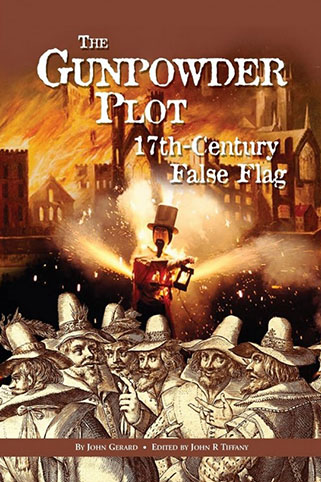Description
 The Gunpowder Plot: 17th-Century False Flag: The Traditional Story Tested Against the Evidence
The Gunpowder Plot: 17th-Century False Flag: The Traditional Story Tested Against the Evidence
By John Gerard. The Gunpowder Plot of 1605—known at the time as the Gunpowder Treason Plot or the Jesuit Treason—was billed as a failed assassination plot against Protestant King James I of England by a group of English Catholics led by Robert Catesby. The official story was that the “conspirators” were going to blow up the House of Lords during the opening of England’s Parliament on the 5th of November by igniting a massive cache of gunpowder stored in the cellars under the houses of Parliament.
The alleged conspirators, we are told, hoped to inspire a widespread revolt in which a Catholic monarch could be placed on the throne. Also allegedly involved in the plot were a number of other Catholics including Guido “Guy” Fawkes, a veteran of the military. Fawkes was supposedly given charge of the explosives.
One version of the “official” story is that he was caught in the act, just as he was lighting the fuse attached to the pile of gunpowder. At their trial on Jan. 27, 1606, eight of the survivors, including Fawkes, were convicted and sentenced to be hanged, drawn and quartered. Almost all of them had confessed after weeks of brutal torture.
The Protestant ruling elite subsequently used the Gunpowder Plot to continue cracking down on the practice of Catholicism in England and foment perpetual war with England’s neighbors. Additional Catholics—lay and clergy alike—were hunted down, tortured and either imprisoned or executed. Many Catholics went into hiding.
But was the Gunpowder Plot a “false flag,” an event in which one group frames another for a crime for some political end? And how does the evidence stand up to real scrutiny? Was the plot even possible?
Was it more likely that members of a government faction had set up the plot themselves using infiltrators and double agents? At the time, propaganda about the event was used to unify the people against Catholics, with state-sponsored holidays in which effigies of Guy Fawkes, in particular, were burned as the public lit bonfires and celebrated the foiling of the “dastardly” scheme.
What’s the truth? Find out in this special edition of an 1897 book by John Gerard, who bears the same name as one of the Catholic priests pursued for involvement in the Gunpowder Plot.
Softcover, 203 pages, 6″×9″


